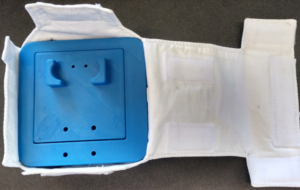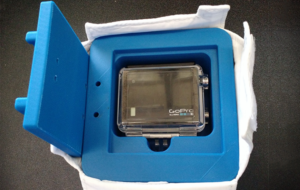 NASA has been making use of 3D printing long before the general public even knew it existed. As the technology has made its way into the mainstream, however, NASA keeps making one headline after another regarding their uses for 3D printing—whether they are industrial, creative, or being encouraged on the university level for futuristic innovation.
NASA has been making use of 3D printing long before the general public even knew it existed. As the technology has made its way into the mainstream, however, NASA keeps making one headline after another regarding their uses for 3D printing—whether they are industrial, creative, or being encouraged on the university level for futuristic innovation.
From looking toward bioprinting in space to using 3D printing for engine igniters, rocket parts, and so much more, engineers at NASA obviously put great faith in a process that not only allows for parts to be built that may not have otherwise been possible, but also leads to faster prototyping and refining and the use of more lightweight materials when required, along with speed in manufacturing and greater affordability all around.
And although 3D printing doesn’t actually lead to creating items out of thin air, that perception may be there for many new to the technology as they hear about astronauts toting software and hardware into space and then creating a variety of tools and parts, and even medical supplies; in fact, it seems this way for many on Earth considering the large-scale projects DIY enthusiasts are able to pull off. As time has gone by though, the use of 3D printed tools at the International Space Station now to seems to be an almost normal activity. Designing and prototyping of such tools is left up to engineers at NASA Johnson Space Center in Houston, using Zortrax M200 and M300 3D printers.
While many tasks in space and those during the preparation process are considered nominal (and documented and described in NASA’s EVA Tools and Equipment Reference Book), others are ‘off-nominal,’ meaning they must be handled on the fly. At NASA Johnson Space Center, that means engineers must be quick on their feet to create 3D printed designs for parts that may be delivered as quickly as three weeks. NASA purchased their first Zortrax 3D printer in 2015, and engineers were able to move forth in creating parts for use in space. While it may be challenging enough to create parts for an industrial atmosphere on Earth, NASA engineers must take extreme conditions into account, along with the bulky spacesuits astronauts are wearing, which may inhibit them from holding tools of the wrong shape or size.
NASA purchased their first Zortrax 3D printer in 2015, and engineers were able to move forth in creating parts for use in space. While it may be challenging enough to create parts for an industrial atmosphere on Earth, NASA engineers must take extreme conditions into account, along with the bulky spacesuits astronauts are wearing, which may inhibit them from holding tools of the wrong shape or size.
“Hence the tool design team at NASA JSC has three main challenges to overcome in their work. First they need to make sure the tool can be utilized by an astronaut wearing a spacesuit with pressurized gloves. Second, they need to make sure the tool functions in the harsh space environment. Third, they need to make tools intuitive and easy to use for all astronauts. Pulling this off takes lots of iterating on various designs. And lots of 3D printed concepts,” explains the Zortrax team in their case study about 3D printing by NASA engineers.
When a new tool must be designed—especially quickly—brainstorming ensues, and a design team begins the process of creating a model that fits within the necessary requirements.
“To an extent, space as the tools’ intended environment determines which post-processing techniques make sense for NASA JSC engineers,” states the Zortrax case study. “Each 3D printed model needs a few finishing touches to be done. The first step is to remove support structures. Then the team goes on to drilling holes depending on the exact size needed and adding thread holes where necessary. Next goes installing inserts and sometimes sanding of edges.”
Complete accuracy is a must in the tools that are required. Because of that, the team may design several different iterations. In one model, for instance, ABS shrinkage was causing problems with shape and diameter. In changing the settings in Z-Suite, they were able to overcome these issues.

Astronaut Mark Vande Hei using the end-use version of an EVA GoPro casing during a spacewalk on Oct. 10, 2017. [Image: NASA]
“Specifically, the engineers utilized the OFFSET feature, an option that allows a user to modify outer contours and holes dimensions of a model, to control for shrinkage,” states the case study. “Overall, the team 3D prints with three dedicated Zortrax materials: Z-ABS, Z-HIPS, and Z-ULTRAT. Parts of tools intended for space are very rarely glued, as most of known glues would not withstand extreme temperatures around the ISS. Hence, the tools are designed to be bolted, rather than glued together.”
With the Zortrax M200 in use since March 2015 and the Zortrax M300 since April 2017, the two machines together have logged over 3,000 hours of use and have created over 1,350 parts in almost 450 work cycles. The Eva GoPro is one part that has been prototyped on the Zortrax, and consequently used in spacewalks by astronauts since 2015.
- A 3D printed prototype of an EVA GoPro casing astronaut Mark Vande Hei used during a spacewalk on Oct. 10, 2017.
- [Images: NASA/JSC]
With the 3D printers now being imperative to their work in creating tools for use in space, the engineers sometimes use their Zortrax machines every single day for several months. Read the case study, and find out more about Zortrax products and services here.
What do you think of this news? Let us know your thoughts; join the discussion of this and other 3D printing topics at 3DPrintBoard.com or share your thoughts below.
Subscribe to Our Email Newsletter
Stay up-to-date on all the latest news from the 3D printing industry and receive information and offers from third party vendors.
You May Also Like
Why Corrosive Resistant Materials Are Important to the Success of 3D Printing Across Industries
The adoption of additive manufacturing (AM) is accelerating across many major industries. As this technological shift unfolds, the importance of corrosion resistance has emerged as a challenge for 3D printing...
America Makes Announces IMPACT 2.0: $6.6M in New 3D Printing Funding
America Makes, the Manufacturing Innovation Institute (MII) based in Youngstown, Ohio, has announced IMPACT (Improvement in Manufacturing Productivity via Additive Capabilities and Techno-Economic Analysis) 2.0, a project call which will...
3D Printing Webinar and Event Roundup: April 14, 2024
We’re starting off the week’s 3D printing webinars and events at ASTM AMCOE’s 11th Snapshot Workshop and MACH Exhibition. Stratasys continues its advanced training courses, SME is holding a virtual...
AMUK Welcomes Airframe Designs as British 3D Printing Industry Grows
While the UK is not the hub for 3D printer and materials manufacturers as other nations, the country continues to excel at the research, development, and application of additive manufacturing...


































